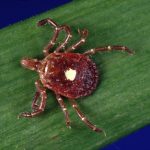How to Get Rid of Lone Star Ticks in Your Fairfax, VA Yard; Identification, Treatment for Bite & More
 Because of the single silvery-white spot marked on the females’ back, the lone star tick was so named. These ticks attack people more frequently than most any other type of tick. They usually leave behind a circular rash and lone star ticks are notorious for spreading harmful diseases. It is crucial that if you discover a lone star tick on you or your pet is immediately removed. In regard to lone star ticks, the we at CSI Home and Commercial Services would like to share some basic information with you today.
Because of the single silvery-white spot marked on the females’ back, the lone star tick was so named. These ticks attack people more frequently than most any other type of tick. They usually leave behind a circular rash and lone star ticks are notorious for spreading harmful diseases. It is crucial that if you discover a lone star tick on you or your pet is immediately removed. In regard to lone star ticks, the we at CSI Home and Commercial Services would like to share some basic information with you today.
Lone Star Tick Identification
Lone star ticks are reddish brown and will look a slate gray when engorged, and as mentioned, the ladies feature a whitish marking on their back. By adulthood, they have 8 legs, qualifying them as arachnids, though as larvae they only have 6 legs. With oval-shaped and flattened bodies, females average between ¼ inch long and ½ inch when engorged and the males are smaller.
Treatment for Lone Star Tick Bite
These ticks can be brought inside your home by you or your pet, though they usually do not survive long indoors. Should you find them latched onto you or your pet, use fine-tipped tweezers to grasp it as close to the skin’s surface as possible. Do not twist or jerk the lone star tick, as this can cause the mouthparts to break off and remain in the skin but pull upward steadily with even pressure. Make sure to dispose the ticks. Wash the bite wound with warm water and soap; contact a doctor if you have a rash, fever, headache, or pains developing. Avoid lone star ticks with long-sleeved clothes and pants along with wearing tick repellent. Stay clear of lounging to long on or against stumps, logs, or bushy areas and after spending time in such areas.
Lone Star Tick Life Cycle; Nymphal Stage & More
Lone star ticks are a a three host tick, meaning that they need a new host with each stage. They initially contact the host by crawling up on the tips of the low-growing vegetation as they lay in wait for a host to pass by. Lone star ticks cannot survive long exposure to the sun and will seek refuge in shaded areas. The habitat must also contain both small animal hosts for larvae, though adults target bigger animals. A favorite habitat for lone star ticks is woods to lawn or meadow transitional zone and for eggs to hatch, and they require 65% or greater humidity levels until they latch on a host. Common small animals the larvae attach to include gray squirrel, cat, ground nesting birds, gray fox, striped skunk, raccoon, cottontail rabbit, and cotton rat. Nymphs will also select one of these smaller animals as well as larger animals the adults prefer including foxes, dogs, wild turkey, cats, cattle, white-tailed deer and people; and humans can support these ticks in all 3 stages.
Lone Star Tick Diseases
Lone star ticks are known vectors for Heartland virus, tularemia, Bourbon virus and Southern tick-associated rash illness (STARI), putting their host at risk for being infected. You can develop a secondary infection when attempting to remove ticks because of the problematic mouthparts.
Tick Control
Especially along the trails, paths, and yard edges, be sure to keep the grass cut short and the vegetation trimmed back to reduce ideal habitats. Preventative pest control maintenance can help as well, but if you find one on you or your pet, be sure to take care of the removal and medical treatment as needed and call CSI Home and Commercial Services to ensure any ticks and viable eggs are eliminated.




